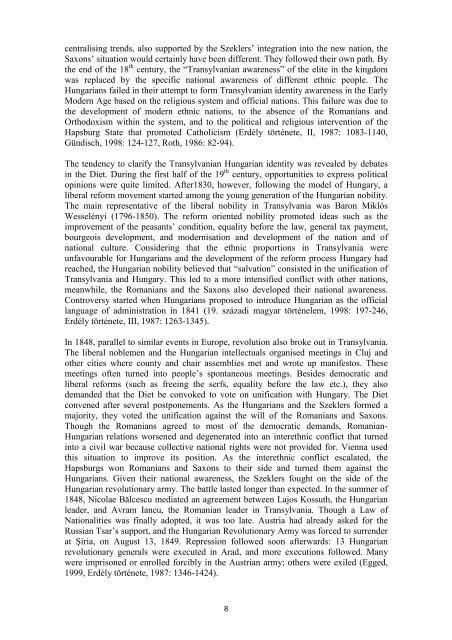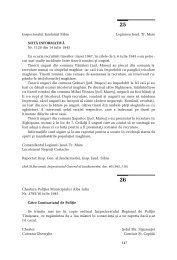Southeast Europe
Southeast Europe
Southeast Europe
You also want an ePaper? Increase the reach of your titles
YUMPU automatically turns print PDFs into web optimized ePapers that Google loves.
centralising trends, also supported by the Szeklers’ integration into the new nation, the<br />
Saxons’ situation would certainly have been different. They followed their own path. By<br />
the end of the 18 th century, the “Transylvanian awareness” of the elite in the kingdom<br />
was replaced by the specific national awareness of different ethnic people. The<br />
Hungarians failed in their attempt to form Transylvanian identity awareness in the Early<br />
Modern Age based on the religious system and official nations. This failure was due to<br />
the development of modern ethnic nations, to the absence of the Romanians and<br />
Orthodoxism within the system, and to the political and religious intervention of the<br />
Hapsburg State that promoted Catholicism (Erdély története, II, 1987: 1083-1140,<br />
Gündisch, 1998: 124-127, Roth, 1986: 82-94).<br />
The tendency to clarify the Transylvanian Hungarian identity was revealed by debates<br />
in the Diet. During the first half of the 19 th century, opportunities to express political<br />
opinions were quite limited. After1830, however, following the model of Hungary, a<br />
liberal reform movement started among the young generation of the Hungarian nobility.<br />
The main representative of the liberal nobility in Transylvania was Baron Miklós<br />
Wesselényi (1796-1850). The reform oriented nobility promoted ideas such as the<br />
improvement of the peasants’ condition, equality before the law, general tax payment,<br />
bourgeois development, and modernisation and development of the nation and of<br />
national culture. Considering that the ethnic proportions in Transylvania were<br />
unfavourable for Hungarians and the development of the reform process Hungary had<br />
reached, the Hungarian nobility believed that “salvation” consisted in the unification of<br />
Transylvania and Hungary. This led to a more intensified conflict with other nations,<br />
meanwhile, the Romanians and the Saxons also developed their national awareness.<br />
Controversy started when Hungarians proposed to introduce Hungarian as the official<br />
language of administration in 1841 (19. századi magyar történelem, 1998: 197-246,<br />
Erdély története, III, 1987: 1263-1345).<br />
In 1848, parallel to similar events in <strong>Europe</strong>, revolution also broke out in Transylvania.<br />
The liberal noblemen and the Hungarian intellectuals organised meetings in Cluj and<br />
other cities where county and chair assemblies met and wrote up manifestos. These<br />
meetings often turned into people’s spontaneous meetings. Besides democratic and<br />
liberal reforms (such as freeing the serfs, equality before the law etc.), they also<br />
demanded that the Diet be convoked to vote on unification with Hungary. The Diet<br />
convened after several postponements. As the Hungarians and the Szeklers formed a<br />
majority, they voted the unification against the will of the Romanians and Saxons.<br />
Though the Romanians agreed to most of the democratic demands, Romanian-<br />
Hungarian relations worsened and degenerated into an interethnic conflict that turned<br />
into a civil war because collective national rights were not provided for. Vienna used<br />
this situation to improve its position. As the interethnic conflict escalated, the<br />
Hapsburgs won Romanians and Saxons to their side and turned them against the<br />
Hungarians. Given their national awareness, the Szeklers fought on the side of the<br />
Hungarian revolutionary army. The battle lasted longer than expected. In the summer of<br />
1848, Nicolae Bălcescu mediated an agreement between Lajos Kossuth, the Hungarian<br />
leader, and Avram Iancu, the Romanian leader in Transylvania. Though a Law of<br />
Nationalities was finally adopted, it was too late. Austria had already asked for the<br />
Russian Tsar’s support, and the Hungarian Revolutionary Army was forced to surrender<br />
at Şiria, on August 13, 1849. Repression followed soon afterwards: 13 Hungarian<br />
revolutionary generals were executed in Arad, and more executions followed. Many<br />
were imprisoned or enrolled forcibly in the Austrian army; others were exiled (Egged,<br />
1999, Erdély története, 1987: 1346-1424).<br />
8









